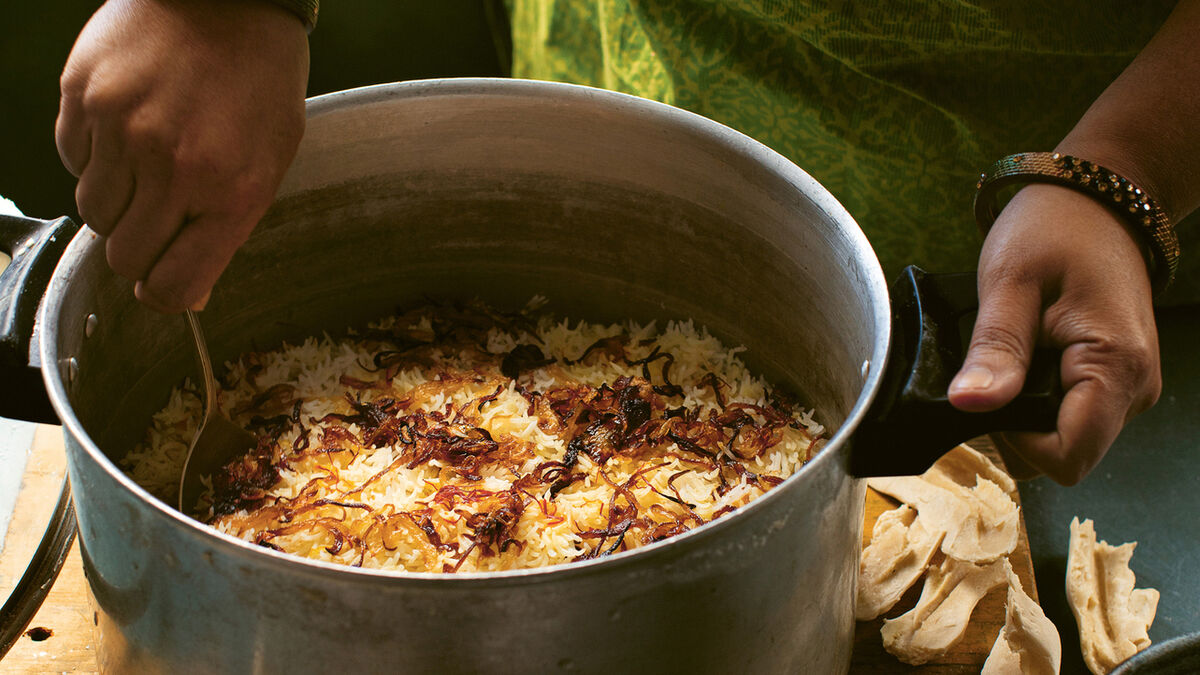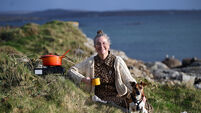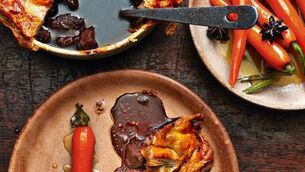The secret to great Indian food and how to make an authentic chicken biryani

Chef Assma Khan says that biryani signalled a celebratory meal in her home, growing up.
“Biryani was always made for big celebratory occasions,” says chef Asma Khan, author of — a cookbook dedicated to her mother.
“This is also usually the last dish I eat at home before I make the five-hour car journey from my parents’ home to the airport to catch my flight to London. I always felt that layered in that biryani were things my mother couldn’t say. When the biryani arrived on the table, it felt like Ammu’s secret code, telling me that she loved me.”
Most chefs have at least a few stories about cooking as a child — food is a passion, and for many, this starts young.
While Asma Khan has plenty of food-related stories from her youth though, she didn’t actually learn how to cook until she got married.

In fact, Khan had no desire to cook at all growing up — “I just wanted to eat,” she says with a laugh — and didn’t see a need to learn. “I didn’t imagine I would leave home and leave India. The presumption was, I would have an arranged marriage into another family similar to mine, where people would have cooks and other people — grown-ups — who would cook,” she recalls.
“I thought I was a child, people are going to feed me — I’m never going to grow up in my life.” Khan did have an arranged marriage, but found herself somewhere quite different: Britain. “I was suddenly in a foreign land with a stranger,” she says — and she swiftly realised the best way to connect herself back to her family and the country she left was through cooking.
“Food became my way of going home, but it also became my language of love,” she explains. “I was cooking not because I enjoyed cooking — I was cooking to heal, and feed and nourish others. I realised Ammu [her mother] did that her whole life too.”
Luckily, Khan’s first adventures in the kitchen were relatively successful. She started with easy dishes, like parathas and koftas (“I didn’t want to pick things I thought I may not be able to do”), and the recipes came easily because she was already so familiar with them.
“I knew how to cook, but I didn’t know how to cook,” she says. Reflecting on her childhood in the kitchen, she explains: “The food that was being cooked, even though I didn’t know how it was being made, I knew the aromas, I knew the sounds — the sizzle of the cumin, the popping of the mustard seeds, the smokiness of the dried chillies… I knew how to recreate these dishes very quickly, because you just have to watch it done once from beginning to end.”

That’s why Khan spends so much time in her new cookbook, , describing the sensory experiences of cooking — how dishes should taste and smell, rather than focusing purely on things like cooking times. ‘Ammu’ is the affectionate term for ‘mother’ for Bengali Muslims — and it was important for Khan to write it in her mother Faizana’s lifetime. It’s full of family recipes, stories from both Khan and her mother’s childhoods, and plenty of pictures — something Faizana was shocked Khan managed to collect.
When Faizana saw the book for the first time, Khan says she was “very emotional” — and also gave surprisingly little feedback. “My mother is not someone who pussyfoots around on these things. She would’ve told me, ‘Why didn’t you put in this recipe?’ — but she loved every recipe I put in, and she thought it was great, because there were things she had forgotten herself as well.”
Her tip for cooking is to take your time. “The most expensive ingredient you put into a dish: time. For me, that is the core of how I still cook,” says Khan.
“It’s about time and generosity — I don’t cook to impress. Heal and nourish has been my philosophy, from the time I learned to cook.”
My mother's chicken biryani
Biryani was always made for big celebratory occasions, this is the perfect dish for a family dinner

Servings
6Preparation Time
10 minsCooking Time
60 minsTotal Time
1 hours 10 minsCourse
MainCuisine
IndianIngredients
200g plain flour
500g good-quality basmati rice
5 tbsp salt
½ tsp saffron strands
80ml full-fat milk
8 tbsp ghee or vegetable oil (sometimes I mix both and it works really well)
2 white onions, thinly sliced into half moons
1kg skinless chicken thighs, on the bone
3 garlic cloves, crushed
5–6cm piece of fresh ginger, grated
2 tbsp full-fat Greek-style yoghurt
½ tsp chilli powder
2 green cardamom pods
2 cloves
1cm piece of cinnamon stick
1cm piece of mace, crushed
⅛ tsp grated nutmeg
¼ tsp sugar
Juice of ½ lemon
Method
Mix the flour with enough water to make a firm dough, cover and leave to rest.
Wash the rice in a bowl of cold water, moving your hand in gentle circular movements in one direction to avoid breaking the delicate tips of the rice (the virtually invisible tips, if broken off, will boil rapidly when the rice goes into the hot water, because of their size, and turn into glue-like starch, which will make all the rice sticky).
Wash the rice in several changes of cold water until the water remains clear. Next, soak the rice. There should be at least 15–20cm of water in the bowl above the rice level. Add six teaspoons of the salt and soak the rice for at least two hours. The long soaking allows the rice to absorb water. As the rice is not hollow and dry when it is put into boiling water, the cooking time is minimised; this will help keep your rice grains long and separate.
Put the saffron in a small bowl. Warm the milk to tepid: my mother would describe it as blood temperature – if you touch the milk it should feel only slightly warm. If you are using a microwave to heat the milk, remember to stir the milk before checking the temperature as there may be hot spots. Pour the tepid milk over the saffron and set aside to infuse.
Heat the ghee or oil in a heavy-based pan over a medium-high heat and fry the onions until caramelised. Using a slotted spoon and leaving as much of the oil in the pan as possible, remove the onions to a plate, spreading them across the plate to cool.
Remove half the oil from the pan and set aside. In the remaining oil add the chicken and cook over a medium-high heat until golden brown on both sides. Add the garlic, ginger, yoghurt, chilli powder and two teaspoons of the salt and cook over a medium-high heat until the garlic and ginger have lost their raw smell and the yoghurt has reduced. Add half the caramelised onions, then add warm water to cover the chicken, bring to the boil, then cover and simmer for about 25 minutes. You do not want the chicken to be tender: it should still be firm, as it will be cooked further with the rice.
Drain the soaked rice. Boil the kettle and pour the water into a large pan. Bring back to the boil, add another six teaspoons salt, then add the drained rice and boil until the rice is three-quarters cooked (this should not take more than five minutes). To test, remove one grain from the boiling water and squeeze it. There should be a hard core to the grain of rice. When the rice reaches this stage, drain and spread it on a tray to prevent it from continuing to cook.
To assemble the biryani you will need a heavy-based pan with a tight-fitting lid. Using a slotted spoon, remove the chicken from its cooking liquid and place it in the pan. Strain the cooking liquid and pour over the chicken. Try to squeeze as much as you can from the onion/ginger/garlic residue, so the stock is nice and thick. It should just about cover the chicken pieces. Next, add the cardamom, cloves, cinnamon, mace and nutmeg. Add half the saffron milk, the sugar and squeezed lemon juice. Then add the rice, ensuring it covers the chicken. On top of the rice add the remaining caramelised onions, the remaining saffron milk and the reserved oil.
Put the biryani pan over a high heat and wait until the steam starts coming out. Let the steam come through for one minute. Meanwhile, roll the dough into tubes and use the dough to seal the lid of the biryani pan. Put the pan on top of an iron frying pan or tawa over a medium-high heat: this is to diffuse the heat. If you do not have an iron pan, put the biryani into a preheated oven at 190°C for 10 minutes. After 10 minutes, turn the oven to 150°C and leave for 20 minutes. If you are using a tawa on the hob, reduce the heat to low, cover the top of the pan with a folded clean kitchen cloth and leave for 20 minutes.
When ready to serve, unseal the biryani lid. Using a large spoon and starting from one side, gently lift the chicken up and mix with the rice. You need to gently merge the wet rice with the dry rice on top, so each grain is perfectly moist.
Ammu: Indian Home-Cooking To Nourish Your Soul by Asma Khan is published by Ebury Press. Photography by Laura Edwards. Available now.





